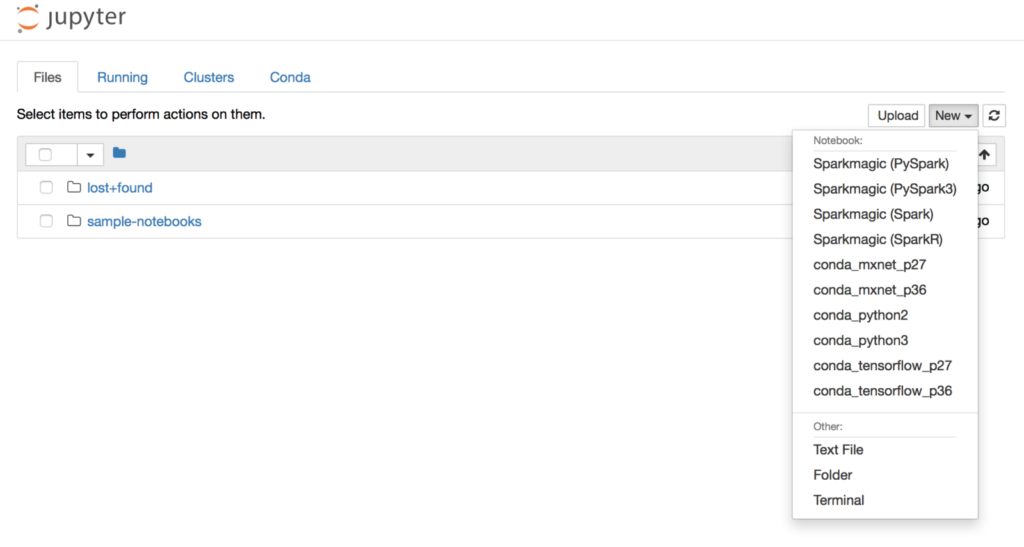
- Python jupyter notebook cloud running how to#
- Python jupyter notebook cloud running mac os x#
- Python jupyter notebook cloud running mac os#
- Python jupyter notebook cloud running software#
- Python jupyter notebook cloud running code#
You will also need to have the Gcloud Command Line Tools installed on your local system. Save the disk image to replicate this environment on any virtual machine.īefore starting, you will need to have Google Cloud Engine account with a billing-enabled project.Access the instance over HTTP to run a Jupyter Notebook in a web browser.Setup a Compute Engine instance with data science libraries.Setting up an environment on GCE provides access to unlimited computing power that can be accessed from any device. I have used both in my professional work, but am especially impressed by the recently revamped GCE interface. Google Cloud Engine (GCE) is basically identical to Amazon Web Services (AWS). Google Cloud Engine for Kaggle Step-by-Step I see two possible solutions - (1) drop a few grand on a high performance PC, or (2) spend about $1 per hour for Google Compute Engine high memory instance. Loading a small dataset is not a problem on my 8GB Macbook, but when you start dealing with millions of rows, memory errors become inevitable… Maximizing the ability to experiment with data means having a reliable environment with ample computing power. To fuel this addiction, much larger processing speeds were needed for preprocessing and deep learning. See the MyBinder website for more information.I recently became addicted to Kaggle competitions. MyBinder is available for the Unidata Python Workshop Jupyter notebooks at this link. If the project has enabled MyBinder, you will see a badge on the github project page. MyBinder is a third option that runs Jupyter notebooks on a cloud server that is setup on your behalf. MyBinder and Starting your Jupyter Notebook in the Cloud Once you have cloned your repository, change directory to where the Jupyter notebooks are located in the repository folder (e.g., the notebooks directory) and start Jupyter with the jupyter notebook command. In order to clone this project or any projects containing Jupyter notebooks such as the Unidata Python Workshop, please see the section on git and github. They are located in the notebooks folder in the git master branch. This project includes a series of Jupyter notebooks for learning Python with geoscience objectives.
Python jupyter notebook cloud running code#
To actually create a notebook, go to the New, Python 3 menu item.Įnter some code in the first cell: print("hello world")Īnd press Shift-Enter to actually run the cell yielding hello worldįor more information on the basics of using the Jupyter Notebook, we recommend starting with this notebook on Notebook Basics. Once entered, this command will automatically launch your default web browser with a new notebook in an empty directory. We can now start our Jupyter notebook with this command: jupyter notebook Click this option to launch the Windows Command Prompt at that specific location. A context menu will appear and there will be an option to, "Open command window here". Hold down the shift key and right-click on the newly created folder.

On Windows, create a Desktop folder called my-notebook. The ~ character is a shortcut to indicate you are at your home directory. Change to that directory (i.e., open the newly created my-notebook folder) with the cd command: cd ~/Desktop/my-notebook. Launch the Terminal again so that we may start Jupyter.

Python jupyter notebook cloud running how to#
In the last section, we learned how to start the OS X Terminal.
Python jupyter notebook cloud running mac os#
On Mac OS X, create a Desktop folder with the Finder called my-notebook.

Starting a Jupyter Notebook in a Specific Folder In both cases, you will want to start the Jupyter notebook in a specific folder. You want to develop a Jupyter notebook or series of notebooks for uses such as supplementing teaching material, or for a scholarly journal article, for example.You aim to further experiment with, or augment, an existing Jupyter notebook like the ones that already exist within a repository in github.There are at least two scenarios in which you may want to run a Jupyter notebook:
Python jupyter notebook cloud running software#
The Jupyter Notebook software is included in the Python installation we obtained from Anaconda. Armed with this experience, we will demonstrate how to start a Jupyter notebook in order to run code.
Python jupyter notebook cloud running mac os x#
In the previous section, we explained how to download and install a complete Python installation with Anaconda for both Mac OS X and Windows. For a more complete treatment of Jupyter notebook software, please read the official documentation.

We will present just enough information to get you started. Here, we will explain how to start a Jupyter notebook. As discussed in the introduction, Jupyter notebooks provide a tremendous advantage for scientific computing, analysis and visualization.


 0 kommentar(er)
0 kommentar(er)
